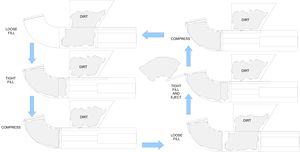CEB Press Molds: Difference between revisions
Jump to navigation
Jump to search
Matt Maier (talk | contribs) No edit summary |
No edit summary |
||
| Line 1: | Line 1: | ||
A lot of people agree that the CEB Press would be more useful if it could press dirt into interchangeable molds. For example, a curved shape could create easy archways, an interlocking shape could create stronger walls, and flat tiles could be fired and put on the roof. | A lot of people agree that the CEB Press would be more useful if it could press dirt into interchangeable molds. For example, a curved shape could create easy archways, an interlocking shape could create stronger walls, and flat tiles could be fired and put on the roof. | ||
[[image:Curved brick CEB press idea.jpg|thumb]] | [[image:Curved brick CEB press idea.jpg|thumb]] | ||
== Press molds in the OSE vertical-stroke CEB press == | |||
The press cycle needs some changes because any mold pattern in the bottom (press foot) side would keep the drawer from ejecting the finished brick cleanly. On possible workaround [http://sketchup.google.com/3dwarehouse/details?mid=9d901ee3c780d495392af48ace8fdc61 here]. | |||
Revision as of 09:47, 5 February 2012
A lot of people agree that the CEB Press would be more useful if it could press dirt into interchangeable molds. For example, a curved shape could create easy archways, an interlocking shape could create stronger walls, and flat tiles could be fired and put on the roof.
Press molds in the OSE vertical-stroke CEB press
The press cycle needs some changes because any mold pattern in the bottom (press foot) side would keep the drawer from ejecting the finished brick cleanly. On possible workaround here.
